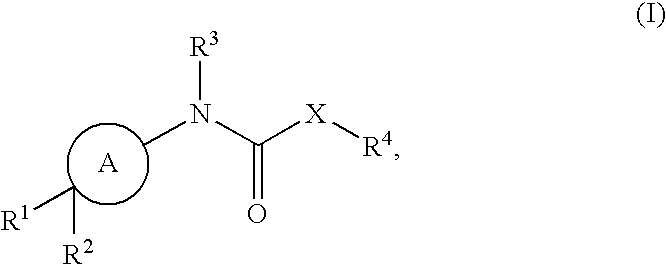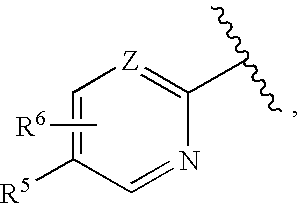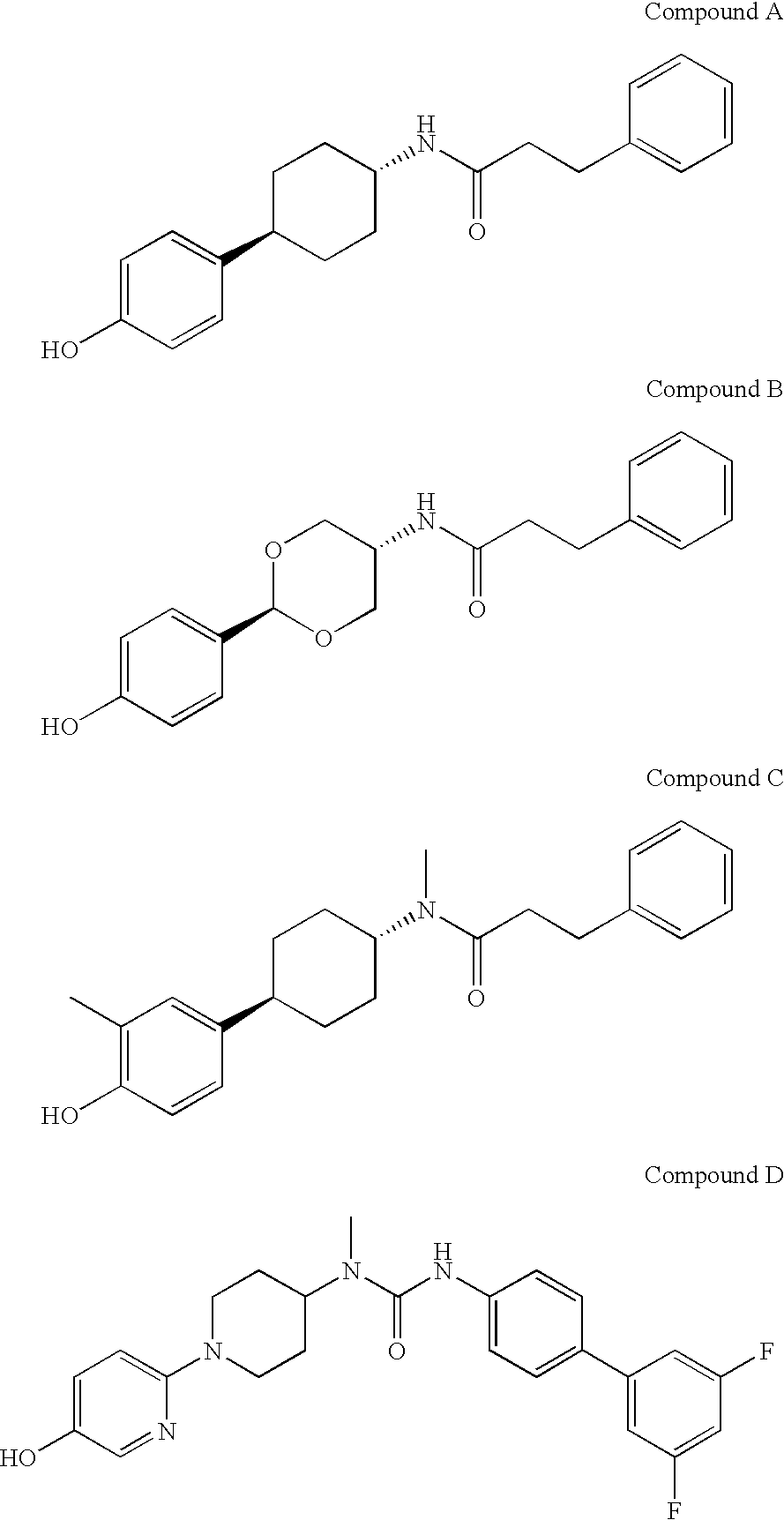Cycloalkylene amide compounds as NR2B receptor antagonists
a technology of cycloalkylene amide and nr2b receptor, which is applied in the direction of biocide, drug composition, cardiovascular disorder, etc., can solve the problems of insufficient nr2b receptor antagonist activity of compound b, insufficient binding affinity of them, and potential serious side effects, so as to achieve potent nr2breceptor binding activity, potent nmda nr2b receptor antagonistic activity, and reduced inhibitory activity
- Summary
- Abstract
- Description
- Claims
- Application Information
AI Technical Summary
Benefits of technology
Problems solved by technology
Method used
Image
Examples
example 1
[0320] 18
[0321] N-[cis-4-Hydroxy-4-(5-hydroxypyridin-2-yl)cyclohexyl]-3-phenylpropa-namide Hydrochloride
[0322] 1-A: N-(trans-4-Hydroxycyclohexyl)-3-phenylpropanamide
[0323] To a solution of trans-4-aminocyclohexanol (8.5 g, 74 mmol) in dichloromethane (200 ml) was added a solution of 3-phenylpropanoic acid (12 g, 81 mmol) in dichloromethane (96 ml). To this mixture were added WSC (16 g, 81 mmol) and HOBt (1.0 g, 7.4 mmol) at room temperature and the mixture was stirred overnight. The volatile materials were removed using a rotary evaporator under reduced pressure to give a residue, which was dissolved in chloroform (700 ml).
[0324] The solution was washed with sat. NaHCO.sub.3 aq., dried over MgSO.sub.4, and evaporated in vacuum. The residue was washed with diisopropyl ether (400 ml) to afford the titled compound as a white powder. (18 g, 97%)
[0325] .sup.1H NMR (DMSO-d.sub.6) .delta.: 7.62 (d, J=7.5 Hz, 1H), 7.29-7.12 (m, 5H), 4.51 (d, J=4.4 Hz, 1H), 3.52-3.27 (m, 2H), 2.78 (t, J=7.6 ...
example 2
[0340] 19
[0341] 3-(4-Chlorophenyl)-N-[cis-4-hydroxy-4-(5-hydroxypyridin-2-yl)cycloh-exyl]propanamide
[0342] 2-A: 3-(4-Chlorophenyl)-N-(trans-4-hydroxycylohexyl)propanamide
[0343] The title compound was prepared from 3-(4-chlorophenyl)propanoic acid by the same manner as example 1-A.
[0344] .sup.1H NMR (DMSO-d.sub.6) .delta.: 7.63 (d, J=7.7 Hz, 1H), 7.31 (d, J=8.4 Hz, 2H), 7.20 (d, J=8.4 Hz, 2H), 4.51 (d, J=4.4 Hz, 1H), 3.50-3.26 (m, 2H), 2.77 (t, J=7.6 Hz, 2H), 2.30 (t, J=7.6 Hz, 2H), 1.85-1.58 (m, 4H), 1.26-1.01 (m, 4H) ppm.
[0345] 2-B: 3-(4-Chlorophenyl)-N-(4-oxocyclohexyl)propanamide
[0346] The title compound was prepared from 3-(4-chlorophenyl)-N-(trans-4--hydroxycyclohexyl)propanamide by the same manner as example 1-B.
[0347] .sup.1H NMR (DMSO-d.sub.6) .delta.: 7.86 (d, J=7.1 Hz, 1H), 7.42-7.18 (m, 4H), 4.10-3.92 (m, 1H), 2.81 (t, J=7.7 Hz, 2H), 2.50-2.16 (m, 4H), 2.37 (t, J=7.7 Hz, 2H), 2.05-1.86 (m, 2H), 1.70-1.50 (m, 2H) ppm.
[0348] 2-C: 3-(4-Chlorophenyl)-N-[cis-4-hydroxy-4-(5-hyd...
example 3
[0353] 20
[0354] 3-(4-Fluorophenyl)-N-[cis-4-hydroxy-4-(5-hydroxypyridin-2-yl)cycloh-exvl]propanamide Hydrochloride
[0355] 3-A: 6-(8-Hydroxy-1,4-dioxaspiro[4.5]dec-8-yl)pyridin-3-ol
[0356] To a solution of 6-bromopyridin-3-ol (8.0 g, 46 mmol) in THF (150 ml) was added dropwise a 1.4 M solution of n-butyllithium in hexane (33 ml, 46 mmol) at -78.degree. C. and the mixture was stirred for 20 min. A 0.90 M solution of sec-butyllitium in cyclohexane (77 ml, 69 mmol) was added dropwise and the mixture was stirred at -78.degree. C. for 1 hour. To the mixture was added a solution of 1,4-dioxaspiro[4.5]decan-8-one (11 g, 69 mmol) in THF (70 ml) dropwise at -78.degree. C. and the mixture was stirred at -78.degree. C. for 1 hour. Sat. NaH.sub.2PO.sub.4 aq. (100 ml) was slowly added to the mixture and the mixture was warmed to room temperature. The organic layer was separated and the aqueous layer was extracted with ethyl acetate (100 ml.times.3). The combined extracts were washed with brine, dri...
PUM
| Property | Measurement | Unit |
|---|---|---|
| temperature | aaaaa | aaaaa |
| temperature | aaaaa | aaaaa |
| temperature | aaaaa | aaaaa |
Abstract
Description
Claims
Application Information
 Login to View More
Login to View More - R&D
- Intellectual Property
- Life Sciences
- Materials
- Tech Scout
- Unparalleled Data Quality
- Higher Quality Content
- 60% Fewer Hallucinations
Browse by: Latest US Patents, China's latest patents, Technical Efficacy Thesaurus, Application Domain, Technology Topic, Popular Technical Reports.
© 2025 PatSnap. All rights reserved.Legal|Privacy policy|Modern Slavery Act Transparency Statement|Sitemap|About US| Contact US: help@patsnap.com



